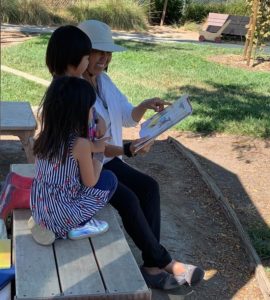California Builds the Capacity of its Teachers to Better Serve DLLs
This new blog series—reported in partnership with New America —will explore California’s new investments in professional development for adults working with the state’s growing population of dual language learners (DLLs).
 Two-thirds of children birth to 5 in California speak a language other than English at home, yet most teachers and care providers lack training in the kind of supports children learning two languages need to succeed.
Two-thirds of children birth to 5 in California speak a language other than English at home, yet most teachers and care providers lack training in the kind of supports children learning two languages need to succeed.
“I visit centers, and teachers ask me for strategies,” said Lizelle Wulff, a quality program manager for Continuing Development, Inc. (CDI), which runs preschools across California. CDI serves children who are native Spanish speakers, but also children who speak Arabic, Hindi, Mandarin, or native dialects from Mexico and South America. Teachers, Wulff said, know they should be using specific strategies to make sure these children can fully participate in their preschool classrooms, but they don’t know how.
In 2018, the California state legislature allocated $5 million towards training early educators to better serve dual language learners (DLLs), children under 6 who speak a language other than English at home. California’s Department of Education oversees the funding to support evidence-based professional development and training to help bilingual children succeed in school, with an emphasis on value and support for a child’s home language as they are learning English.
This new effort is part of a series of new policies in California that place value on bilingualism and multiculturalism, a major shift for the state after 20 years of English-only education.
For many educators, it is a long time coming.
“I would describe it as a hunger,” said Anya Hurwitz, the executive director of the Sobrato Early Academic Language Model, which conducts training for teachers in working with DLLs. “Teachers are really looking for this kind of information and support and have been for some time.”
In 2017, voters passed Proposition 58 repealing the state’s English-only education law. The state adopted new English Language Development Standards and the English Learner Roadmap that same year. Both emphasize intellectual rigor, supporting home language instruction, and ensuring meaningful access to the entire curriculum for all students. (Under old models, children learning two languages were too often sidelined into remedial classes without access to science or social studies, for example). California was the first state to adopt a Seal of Biliteracy, and a new initiative Global California 2030 aims to provide more opportunities for students to learn a second or third language at school and to train bilingual teachers.
The California Department of Education, along with advocates, are working to ensure widespread use of these tools across California and to ensure teachers can be effective. They are also emphasizing the importance of starting this support early and involving families.
Online courses are available for family child care providers or preschool teachers to learn strategies for working with families, like ensuring that children’s home language is spoken and valued at home and that the home language and culture is incorporated into early childhood classrooms.
Programs like the Sobrato Early Academic Language Model (SEAL) and Preschool Guided Language Acquisition Design (Preschool GLAD) are developing and expanding training for preschool teachers, including those who work in dual language programs. And in the Central Valley, where most children under 6 are learning two languages, training models are reaching teachers of infants and toddlers who train alongside preschool teachers from the local school district.
“This has provided opportunities for agencies who otherwise would not have been able to be involved due to cost and time,” said Carolyne Crolotte, senior policy analyst with Early Edge California.
Projects that received state funding to provide early educators with professional development include the California Preschool Instructional Network, the Faculty Initiative Project, the Language Learning Project, Preschool GLAD, SEAL, and California State University Channel Islands.
This work is not without challenges. Many programs lack resources or infrastructure to bring in substitutes so teachers can be excused to attend training programs. In several of these programs, teachers are coming in on evenings or weekends to attend. But experts see promise.
“We are really excited about this,” Patricia Lozano, executive director at Early Edge California who helped advocate for these investments. “We see a great need here and are thrilled the state has stepped up to support this work. We know from the research that these strategies can make a difference for young dual language learners and we’re seeing that come alive in these pilot classrooms and centers across the state. With continued investment California can really be a leader here. We hope this is just the beginning.”
The effort is being followed closely for its impact on children. First 5 California and local foundations are providing support for several research efforts that will examine how instruction, family engagement, and professional development support dual language learners and their families. The studies will examine how professional development affects teachers’ knowledge and use of evidence-based strategies in their classroom. With philanthropic support, Early Edge California has been meeting regularly with the grantees in order to track progress. The organization is using the findings and policy implications that come from these studies to make the case for ongoing investment.
“We need a cadre of teachers who are trained to support California’s large population of young DLLs,” Lozano said. “Our collective success depends on it.”
